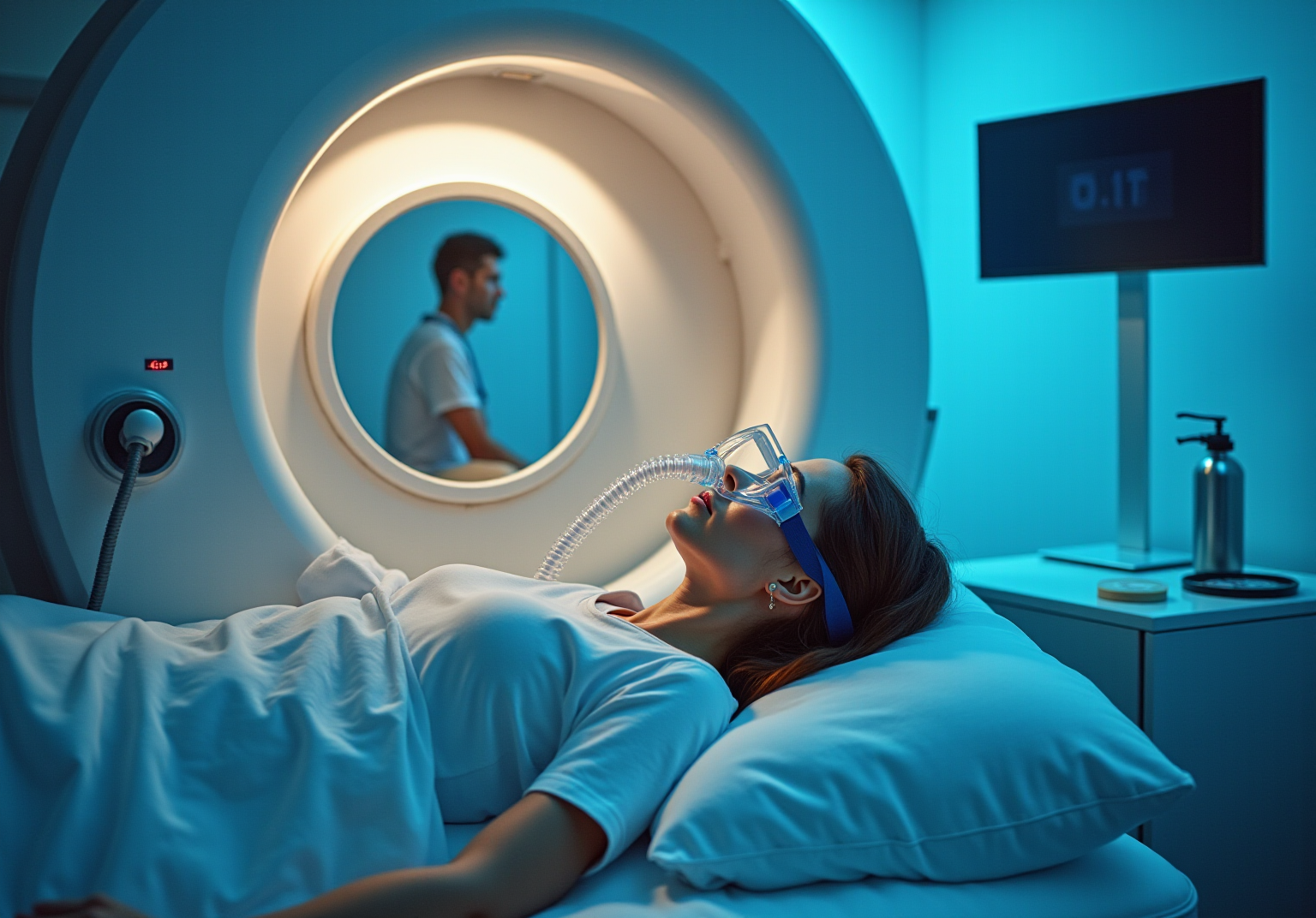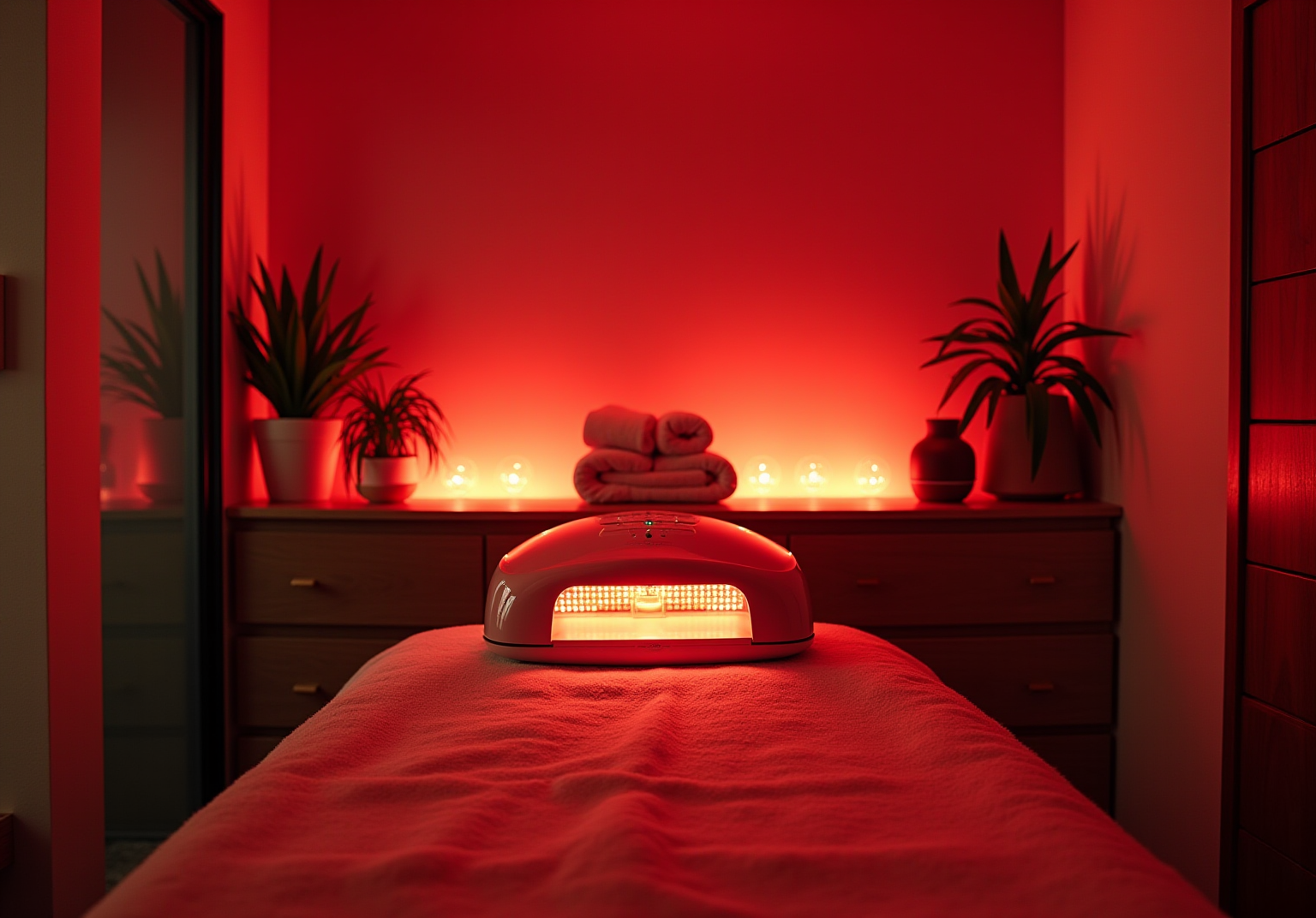Master Red Light Therapy: Benefits, Safety, and Techniques Explained
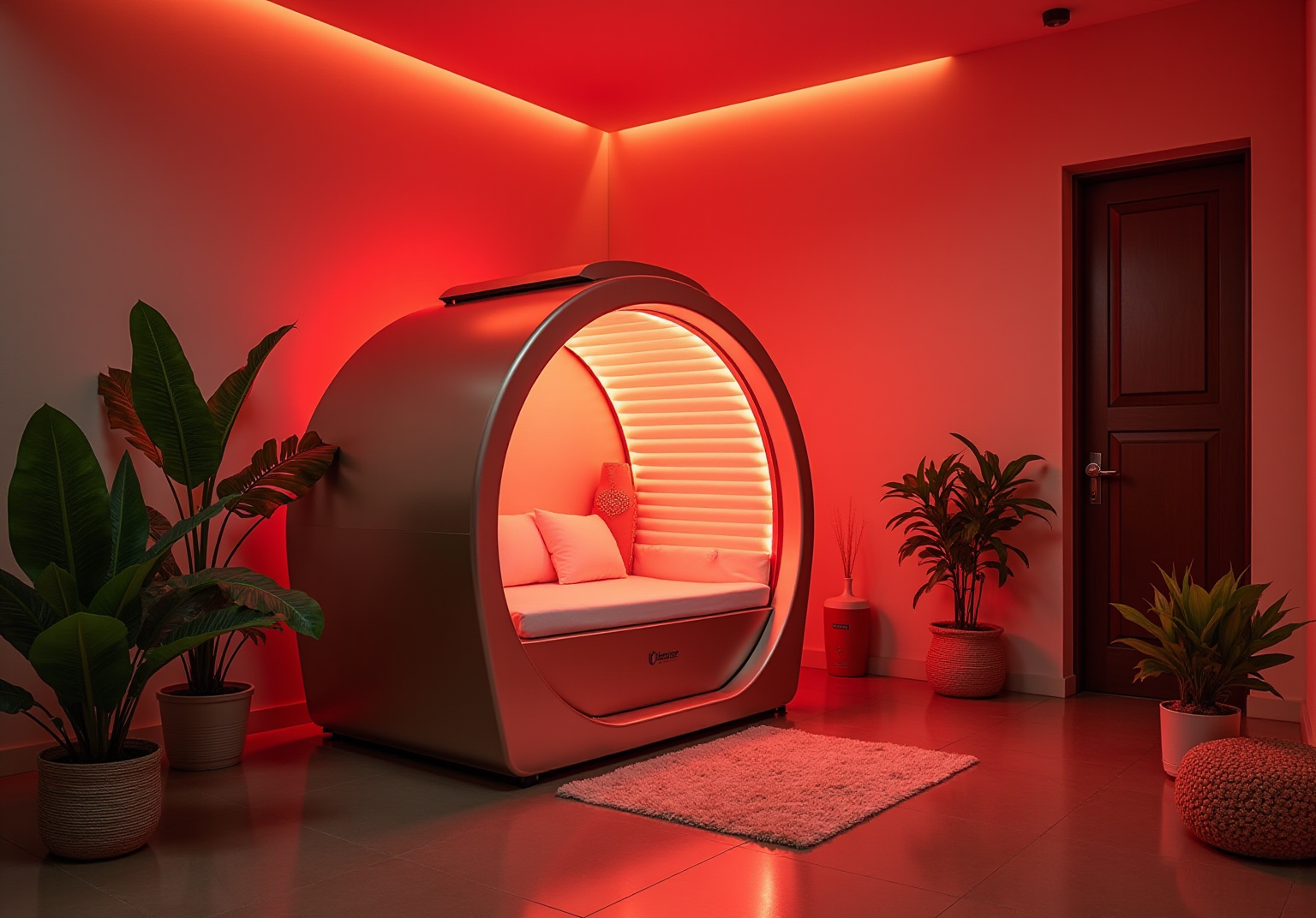
Overview
Red light therapy (RLT) stands out for its numerous benefits, including enhanced skin health, pain relief, improved recovery, mood enhancement, and hair growth. This treatment is recognized as a safe and non-invasive option, making it increasingly appealing. At the cellular level, RLT boosts energy production, a mechanism that underpins its effectiveness. Clinical studies further validate its efficacy across various therapeutic applications, reinforcing its credibility in the health and wellness sector. Embracing RLT could be a transformative step towards better health outcomes.
Introduction
The healing power of light has captivated humanity for centuries. Today, modern science unveils red light therapy (RLT) as a compelling intersection of innovation and wellness. This pioneering treatment employs low-wavelength red rays to stimulate vital cellular processes, providing a multitude of benefits—from improved skin health to faster muscle recovery. Yet, as with any therapeutic approach, lingering questions about safety and optimal use remain.
What sets RLT apart in the holistic health landscape, and how can individuals harness its full potential while mitigating risks? The answers to these questions are crucial for anyone considering this transformative therapy.
Define Red Light Therapy: Principles and Mechanisms
Red light therapy light utilizes low-wavelength red rays to penetrate the skin, effectively stimulating cellular processes. The primary mechanism involves the absorption of photons by mitochondria— the cell's energy factories— significantly enhancing the production of adenosine triphosphate (ATP). This surge in ATP boosts , leading to improved function and accelerated healing. Red light therapy light is widely recognized for its therapeutic applications, which include skin rejuvenation, pain relief, and inflammation reduction.
Studies have demonstrated that RLT can effectively alleviate joint pain and stiffness associated with conditions like arthritis by reducing inflammation and promoting tissue repair. Furthermore, RLT is linked to enhanced muscle recovery, as it aids in the removal of lactic acid and supports increased blood flow, delivering essential nutrients to muscles. At Tsavo Wellness, our whole-body red light therapy light treatment pod offers a non-invasive, non-thermal, and non-ablative method that enhances cellular repair and regeneration processes. Each treatment session lasts 20 minutes and employs both red and near-infrared illumination to maximize benefits.
Health professionals emphasize that the red light therapy light is a safe option for those seeking to improve their overall wellness. Susan Poole, BPE MEd, notes that red light therapy light treatment provides numerous advantages, ranging from enhancing skin wellness and alleviating discomfort to aiding muscle recovery and encouraging mental health. Moreover, RLT is supported by over 4,000 published medical studies, establishing it as a credible and effective treatment option. By understanding these principles, individuals can effectively incorporate RLT into their wellness routines, maximizing its potential health benefits.
Experience the transformative effects of RLT at Tsavo Wellness, where we also offer a state-of-the-art infrared sauna experience, allowing you to indulge in up to 50 minutes of self-care in a luxurious setting.
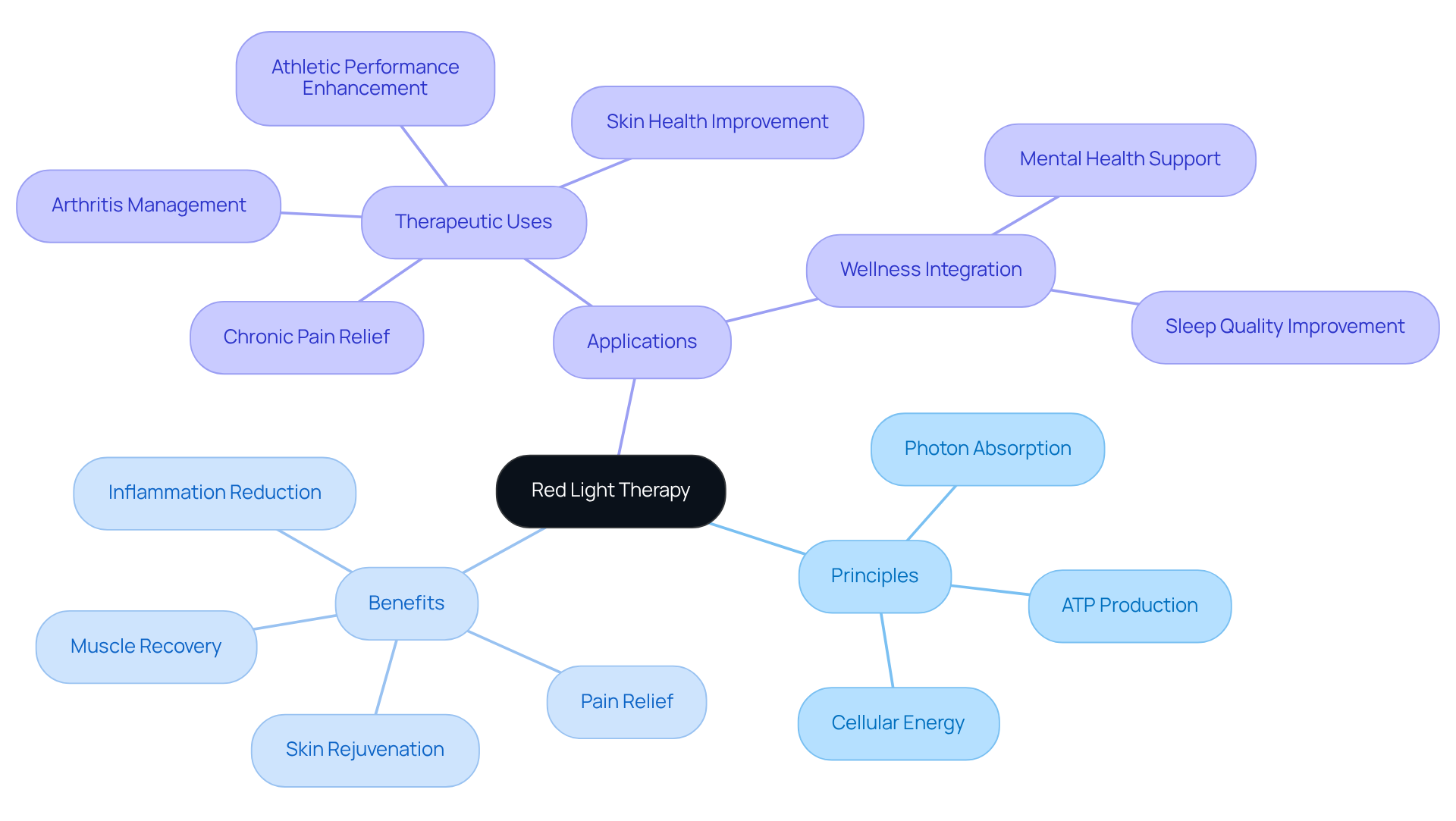
Trace the History and Evolution of Red Light Therapy
Red light therapy (RLT) has its origins in the early 20th century, initially used to treat skin conditions. The ancient Egyptians recognized the healing properties of specific wavelengths, employing colored glass to filter light for therapeutic purposes. Over the decades, technological advancements and research have broadened RLT's applications. Notably, in the 1960s, NASA harnessed RLT to promote plant growth in space, uncovering that red and near-infrared light wavelengths stimulate cellular activity and enhance tissue repair by boosting ATP production. This groundbreaking research paved the way for further investigations into RLT's effects on human health.
By the 1990s, clinical studies began to validate the benefits of RLT for wound healing and pain management, resulting in over 50,000 published studies on the subject. Today, the use of red light therapy light is widely recognized in both clinical and home settings, reflecting an within holistic health practices. At Tsavo Wellness, we harness the potential of red light therapy light as part of our commitment to enhancing health and vitality through innovative treatments. Our Mosman centre offers whole-body red illumination therapy, a science-supported, non-invasive procedure designed to stimulate cellular activity and promote tissue repair, aligning seamlessly with our holistic approach to well-being.
As technology continues to advance, future developments may further personalize RLT treatments, enhancing their efficacy and accessibility. Embrace the transformative power of red light therapy light and experience the benefits for yourself.
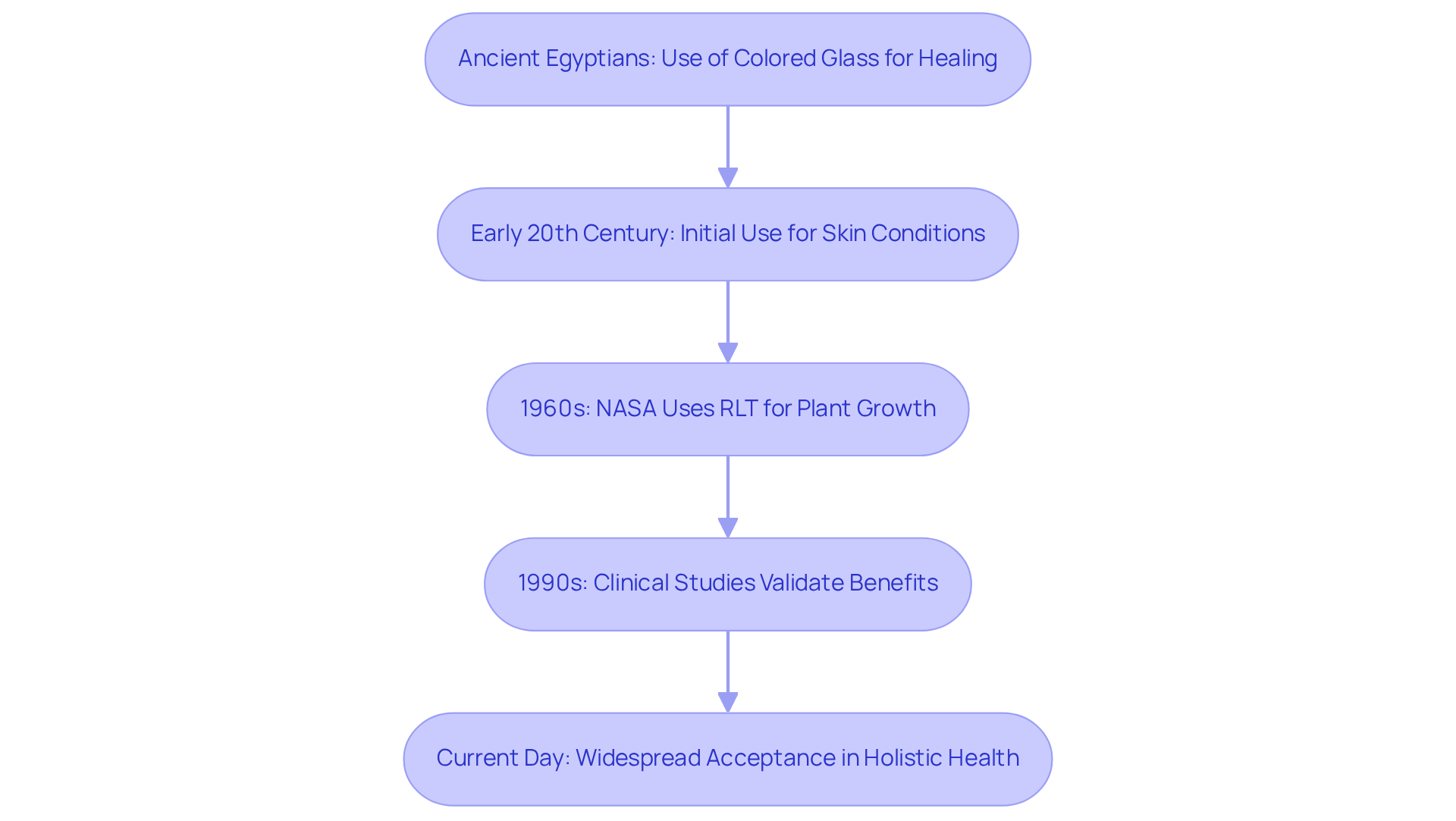
Explore the Benefits of Red Light Therapy for Health and Recovery
Red light therapy light is a powerful addition to any wellness regimen at Tsavo Wellness, providing a multitude of health benefits that warrant attention. Among the most compelling advantages are:
- Enhanced Skin Health: RLT is known to significantly boost collagen production, effectively reducing wrinkles and improving overall skin tone. Research indicates that participants have reported notable enhancements in skin texture and elasticity following consistent sessions with red light therapy light.
- Pain Relief: This treatment excels in alleviating chronic pain conditions by using red light therapy light to reduce inflammation and foster healing. Recent clinical trials reveal that the red light therapy light can lead to a substantial decrease in pain levels, with some studies documenting reductions of up to 50% in chronic pain symptoms over several weeks.
- Improved Recovery: Athletes frequently turn to red light therapy light to expedite muscle recovery after intense workouts. Testimonials from professional athletes underscore their positive experiences, highlighting quicker recovery times and diminished muscle soreness after integrating red light therapy light into their post-exercise routines.
- Mood Enhancement: Exposure to red light therapy light has been associated with improved mood and elevated energy levels, positively impacting mental health. Regular sessions of red light therapy light can help alleviate feelings of fatigue and enhance overall well-being.
- Hair Growth: Red light therapy light has been shown to effectively stimulate hair follicles, aiding in regrowth for individuals experiencing thinning hair. Clinical observations suggest that consistent use of a red light therapy light can lead to visible improvements in hair density and overall health.
- Safety and Side Effects: RLT is regarded as safe and non-invasive, with minimal side effects. The most common side effect is temporary skin reddening, which typically resolves within 24 hours. Rarely, some individuals may experience mild eye irritation, but this is also transient.
These diverse benefits highlight red light therapy light's versatility as a therapeutic tool at Tsavo Wellness, especially for those seeking to and well-being.
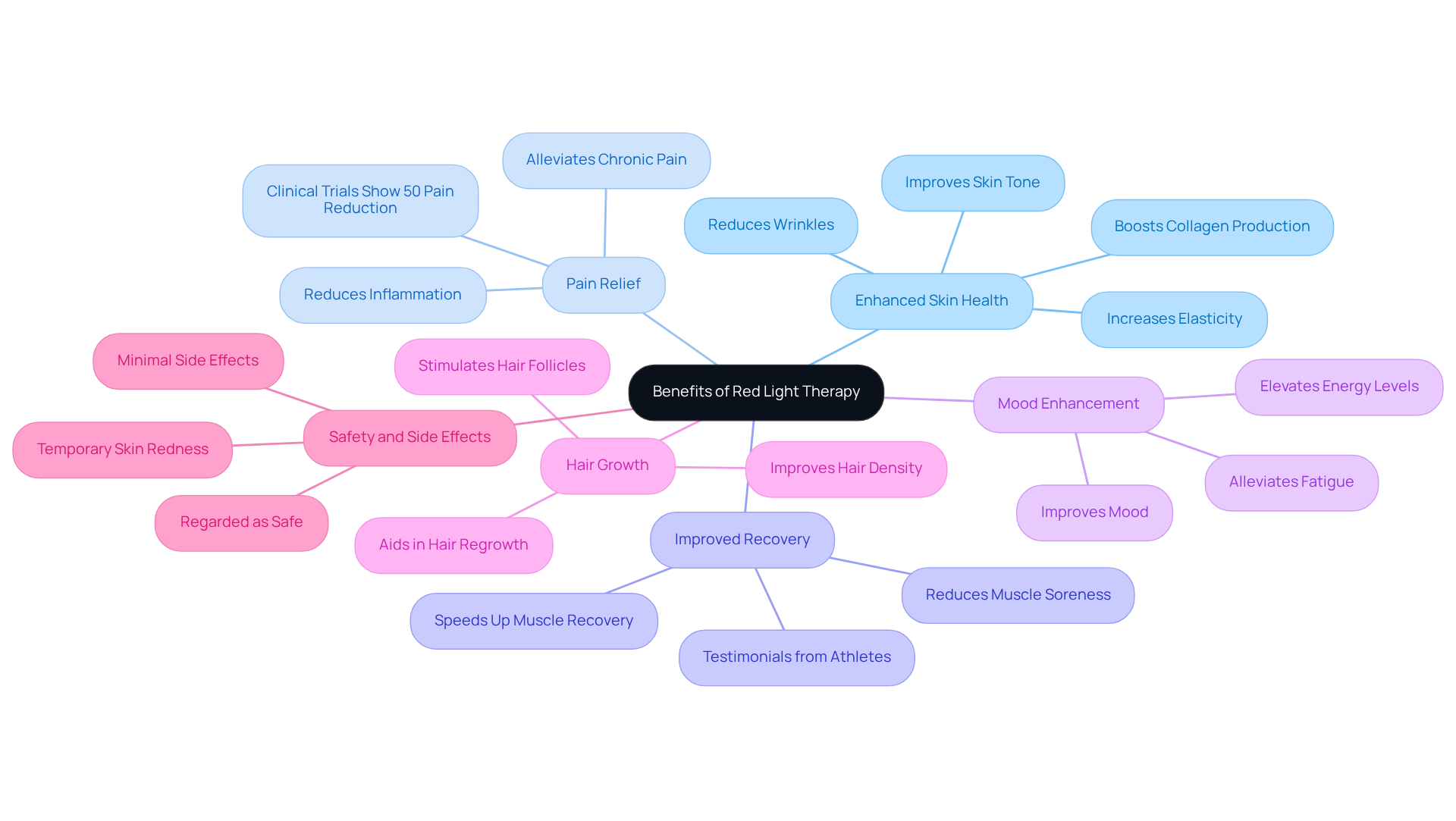
Assess the Safety and Risks of Red Light Therapy
Red illumination treatment is widely regarded as safe for most individuals when applied correctly; however, understanding the potential risks is critical for effective use.
- Eye Protection: Direct exposure to red rays may pose risks to eye health. Medical professionals strongly recommend wearing protective eyewear during treatments to guard against any potential harm. Dr. Elizabeth Hawkes, a Consultant Ophthalmologist, emphasizes that while red illumination treatment offers numerous benefits, adequate eye shielding is essential to prevent discomfort and ensure safety.
- Skin Sensitivity: Some users may experience temporary redness or irritation following treatment. Although many find red illumination beneficial, a minority may encounter mild skin sensitivity reactions, such as migraines or eye discomfort. These reactions are typically short-lived and resolve quickly. Users should monitor their skin's response and adjust treatment frequency as necessary.
- Medical Conditions: Individuals with specific medical conditions, such as retinal disorders or those taking photosensitizing medications, should consult a healthcare provider prior to initiating red illumination treatment. This precaution is vital for mitigating any risks associated with their unique health circumstances.
By understanding these safety considerations, users can confidently incorporate red illumination treatment into their wellness routines while minimizing the likelihood of adverse effects. Furthermore, sessions at Tsavo Wellness last for 20 minutes, providing a non-invasive solution for pain relief and inflammation reduction, thereby promoting overall skin health and enhancing recovery. This treatment, which involves red light therapy light, effectively , making it an excellent choice for those looking to improve their athletic performance and overall healing.
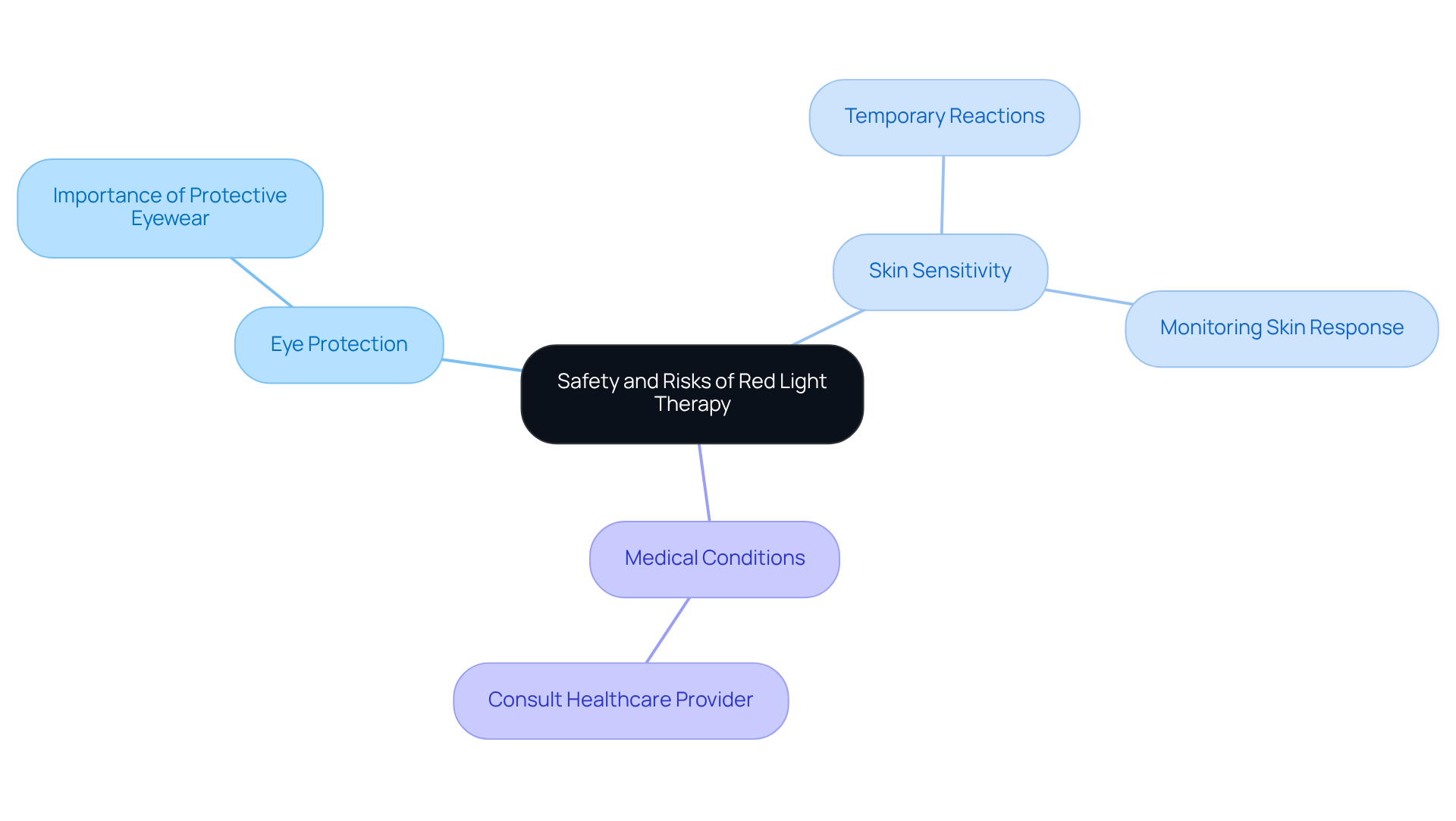
Implement Red Light Therapy: Techniques and Best Practices
To effectively implement at Tsavo Wellness, it is crucial to adopt specific techniques and best practices that will maximize results.
- Choose the Right Device: Selecting a high-quality red light therapy (RLT) device is essential. Opt for devices that emit wavelengths between 630-850 nanometers for optimal red light and near-infrared light. Recommended options include the Flex Mini, Flex Mid, and Flex Max, which provide superior irradiance exceeding 212 mW/cm² and energy density necessary for effective treatment. This choice supports systemic healing and enhances overall vitality.
- Determine Treatment Duration: Treatment sessions should generally last between 10 to 20 minutes, customized to the device and treatment area. For skin conditions, aim for 5 to 15 J/cm² per session. Shorter sessions of 1 to 5 minutes per area can be effective, while deeper tissue treatments may necessitate longer durations. This strategy not only aids in pain relief but also promotes recovery and improves skin health.
- Frequency of Use: For optimal outcomes, target 3 to 5 sessions per week. Consistency is vital; research indicates that regular use can lead to marked improvements in skin texture and pain relief, with some patients experiencing benefits within just a few weeks. Notably, individuals using self-applied illumination devices reported a 70% reduction in inflammatory acne, underscoring the effectiveness of RLT across various applications.
- Positioning: Correct positioning of the device is paramount to effectively target the desired area. Maintain a distance of 6 to 12 inches from the skin to ensure effective illumination penetration while maximizing comfort, which is essential for a relaxing and beneficial session.
- Consistency is Key: Regular use is critical for achieving and sustaining the benefits of RLT. Chronic pain often recurs within weeks after ceasing treatment, so users should establish a consistent schedule to adhere to their plan. This practice enhances strength, endurance, and overall recovery.
By following these guidelines, users can maximize the effectiveness of red light therapy at Tsavo Wellness and seamlessly integrate it into their wellness routines, thereby enhancing both physical and mental wellbeing.
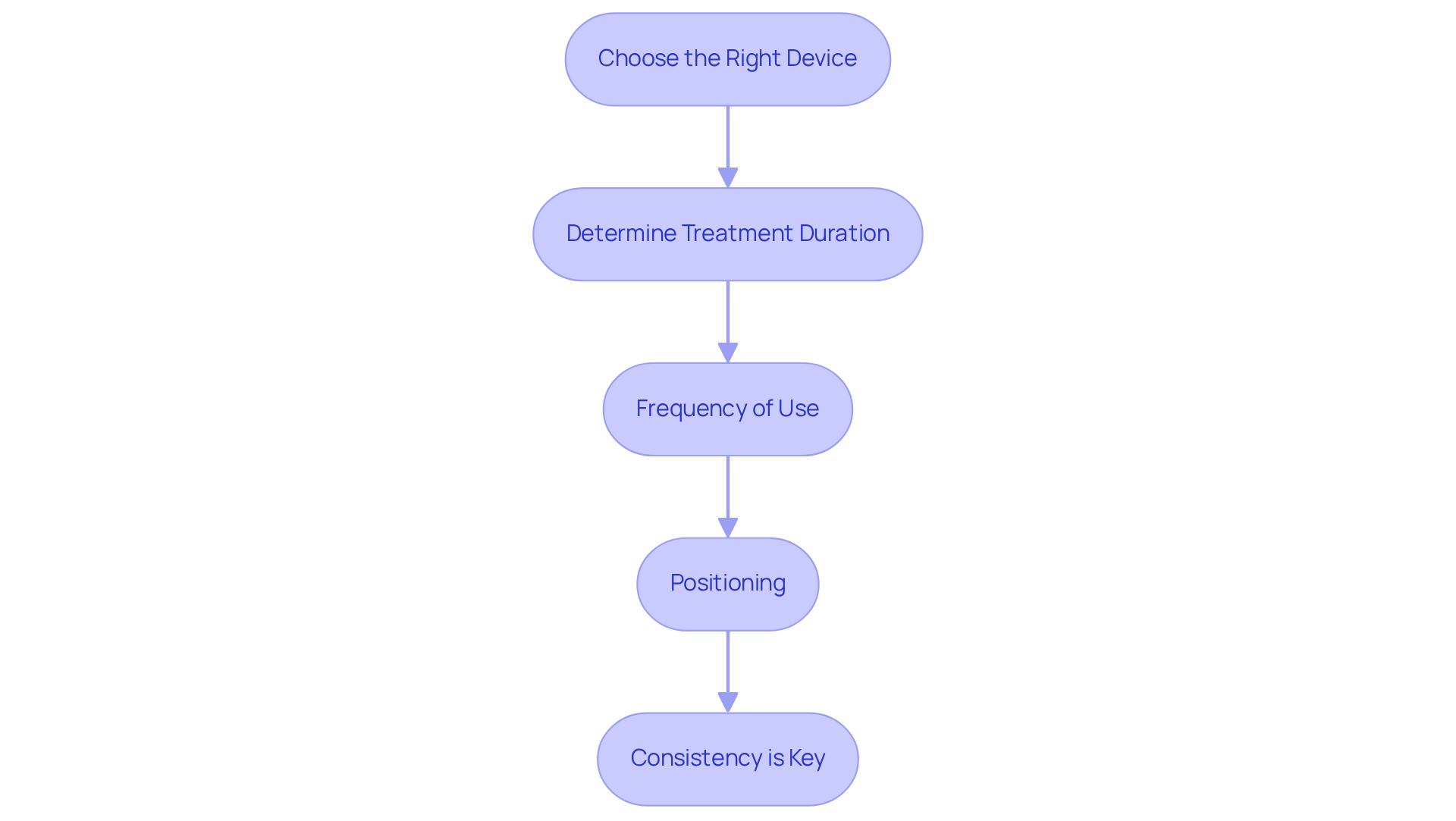
Conclusion
Red light therapy (RLT) stands as a transformative tool for enhancing health and wellness, harnessing the power of low-wavelength red light to stimulate cellular processes and promote healing. By grasping its principles and mechanisms, individuals can leverage RLT's potential across various applications, ranging from pain relief and skin rejuvenation to muscle recovery and mood enhancement.
The exploration of RLT reveals several key benefits, notably its effectiveness in:
- Reducing inflammation
- Accelerating recovery
- Improving skin health
The historical context showcases a rich evolution of the therapy, tracing its origins from ancient practices to modern clinical applications, all supported by a substantial body of scientific research. Safety considerations remain paramount, underscoring the necessity of protective measures and proper usage to ensure a positive experience with minimal side effects.
As the understanding of red light therapy continues to expand, so too does the opportunity for individuals to incorporate this innovative treatment into their wellness routines. Embracing RLT can lead to significant enhancements in overall vitality, positioning it as essential for those aiming to elevate their health and well-being. Taking the first step towards integrating red light therapy into your life could very well be the key to unlocking a healthier, more vibrant existence.
Frequently Asked Questions
What is red light therapy and how does it work?
Red light therapy (RLT) utilizes low-wavelength red rays to penetrate the skin, stimulating cellular processes. The primary mechanism involves the absorption of photons by mitochondria, which enhances the production of adenosine triphosphate (ATP), boosting cellular energy and improving function and healing.
What are the therapeutic applications of red light therapy?
RLT is recognized for various therapeutic applications, including skin rejuvenation, pain relief, and inflammation reduction. It can alleviate joint pain and stiffness associated with conditions like arthritis, enhance muscle recovery, and support overall wellness.
How does red light therapy aid in muscle recovery?
RLT aids muscle recovery by helping to remove lactic acid and increasing blood flow, which delivers essential nutrients to the muscles.
Is red light therapy safe?
Yes, health professionals emphasize that red light therapy is a safe option for those seeking to improve their overall wellness, with numerous advantages supported by over 4,000 published medical studies.
What is the history of red light therapy?
RLT originated in the early 20th century for treating skin conditions. Ancient Egyptians used colored glass for therapeutic light. In the 1960s, NASA discovered RLT's effects on cellular activity and tissue repair, leading to further research and validation of its benefits by the 1990s.
How is red light therapy used today?
Today, RLT is widely used in both clinical and home settings, reflecting an increased acceptance of light-based therapies within holistic health practices.
What can one expect during a red light therapy session at Tsavo Wellness?
At Tsavo Wellness, a red light therapy session lasts 20 minutes and employs both red and near-infrared illumination in a whole-body treatment pod, enhancing cellular repair and regeneration processes.
Are there any additional services offered at Tsavo Wellness?
Yes, Tsavo Wellness also offers a state-of-the-art infrared sauna experience, providing up to 50 minutes of self-care in a luxurious setting.

